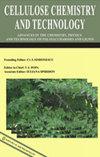CHEMICAL MODIFICATION FOR RESISTANCE TO PHOTO-OXIDATIVE DEGRADATION AND IMPROVED BLEACHING AND COLOR FASTNESS PROPERTIES OF HEMP FIBER
IF 1.1
4区 农林科学
Q2 MATERIALS SCIENCE, PAPER & WOOD
Cellulose Chemistry and Technology
Pub Date : 2023-07-20
DOI:10.35812/cellulosechemtechnol.2023.57.49
引用次数: 0
Abstract
The objective of the research has been to overcome some inherent drawbacks of hemp fiber via chemical modification, which is a vital issue in using it as a textile fiber like cotton. Hemp fiber was modified with treatment liquor (mixture of sulfurous acid and sodium hydroxide) in aqueous medium to remove lignin. The effects of the treatment liquor concentration, fiber to liquor ratio, reaction time and temperature on the percent lignin extracted from hemp fiber were studied. Modified hemp fibers (MHF) were bleached in an alkaline pH aqueous medium with hydrogen peroxide. The process significantly improved lignin removal, bleaching and color fastness. In fact, the whiteness index of bleached MHF was significantly higher than that of bleached raw hemp, but its tensile strength was slightly affected. The photo-oxidative degradation of hemp fiber was 70% lower than that of unmodified (raw) hemp fiber and almost like that of cotton yarn. The color fastness properties of dyed bleached modified hemp fiber were significantly better than those of dyed bleached unmodified hemp fiber and close to those of dyed bleached cotton yarn.化学改性对大麻纤维抗光氧化降解及改善其漂白和色牢度性能的影响
本研究的目的是通过化学改性克服大麻纤维的一些固有缺陷,这是将其用作棉花等纺织纤维的一个重要问题。采用处理液(亚硫酸和氢氧化钠的混合物)在水介质中对大麻纤维进行改性,以去除木质素。研究了处理液浓度、纤维液比、反应时间和温度对大麻纤维木质素提取率的影响。改性大麻纤维(MHF)在碱性pH水介质中用过氧化氢漂白。该工艺显著提高了木质素的去除、漂白和色牢度。事实上,漂白MHF的白度指数明显高于漂白生麻,但其抗拉强度略有影响。大麻纤维的光氧化降解率比未改性(生)大麻纤维低70%,与棉纱几乎相同。染色漂白改性大麻纤维的色牢度明显优于染色漂白改质大麻纤维,接近染色漂白棉纱。
本文章由计算机程序翻译,如有差异,请以英文原文为准。
求助全文
约1分钟内获得全文
求助全文
来源期刊

Cellulose Chemistry and Technology
工程技术-材料科学:纸与木材
CiteScore
2.30
自引率
23.10%
发文量
81
审稿时长
7.3 months
期刊介绍:
Cellulose Chemistry and Technology covers the study and exploitation of the industrial applications of carbohydrate polymers in areas such as food, textiles, paper, wood, adhesives, pharmaceuticals, oil field applications and industrial chemistry.
Topics include:
• studies of structure and properties
• biological and industrial development
• analytical methods
• chemical and microbiological modifications
• interactions with other materials
 求助内容:
求助内容: 应助结果提醒方式:
应助结果提醒方式:


